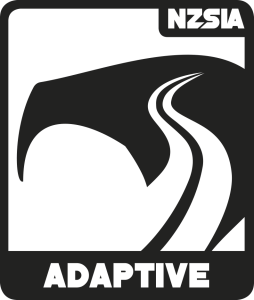Intro to Snowboarding
 What, Who, How
What, Who, How
What
Snowboarding is a great option for a lot of adaptive students. It may include use of outriggers, tethers and prosthetics.
Who
Anyone with the ability to stand is able to learn to snowboard. Snowboarding is a particularly great option for students without individual leg movement and/or femoral retroversion (duck feet) or with prosthetics. See the Physical Assessment model to understand more.
How
Adaptive snowboarding is taught in a similar way to non-disabled snowboarding, however more focus is placed on the students’ goals and the movements they can make. A good Assessment will allow us to understand our students well and relate these to snowboarding. When assessing a student’s movements, focus on what movements they will need to make in order to make a snowboard turn.
Things to think about during the assessment:
- How will they tilt and twist their board to edge?
- How will they flex to pressure their board?
- How will they pivot to steer?
- Are they able to balance without external support?
Once the assessment is complete, utilise the SBINZ beginner progression whilst making adaptations to the movements required.

 Terrain, Equipment & Safety
Terrain, Equipment & Safety
Terrain
Use terrain which is suitable for the level of the student and their appropriate abilities, as per the SBINZ E-Manual.
Equipment
- Outriggers to assist with balance.
- Tethers attached with links to assist with movement.
- Ski Pal to help the instructor support the student’s movements.
- Ankle foot orthosis (AFO)
Outriggers can often assist as a teaching tool for a snowboarder to maintain balance until they develop a feeling for the edge change. If using outriggers with a snowboard, the front outrigger will be placed just behind the tip of the board and the back outrigger will be placed in front of the back foot. Set up the length so they support the rider/skier in a natural stance and screw out the brake so that it provides friction for support. A snowboarder using outriggers will generally need to be set up in a more alpine stance (positive binding angles). The stronger leg should be used as the front foot, when using a prosthetic this should be used as the back foot.
Safety
Helmets are recommended. Be careful not to get tangled when using other equipment and teach safe falling technique with outriggers.

 Corrective Teaching
Corrective Teaching
Student struggles to balance on their snowboard:

